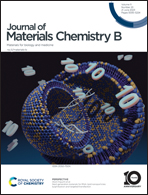Quantitative and biosafe modification of bifunctional groups onto carbon dots by click chemistry†
Abstract
Surface functionalization can effectively affect the properties of carbon dots (CDs), for example, improved solubility and dispersibility as well as enhanced selectivity and sensitivity. However, it is still a challenging task to tailor one or more specific functionalities of CDs via precise surface modification. In this study, click chemistry is applied to engineer CD surface functionalization, where the fluorescent molecule Rhodamine B (RhB) can be efficiently grafted onto the glucose-based bare CDs. The reaction process is quantitatively analyzed, which provides the basic theory for the functionalization of glucose-based CDs by double fluorescent molecules, namely RhB and Cy7. The fluorescence behavior of CDs can be accurately regulated by adjusting the molar ratio of the two molecules. The results of cell proliferation and apoptosis behavior of functionalized carbon dots show that the linkers (triazole structure) introduced by click chemistry have good biocompatibility. This quantitative and multifunctional modification method of CDs has undoubtedly greatly expanded its application field, especially in biological and medical aspects.



 Please wait while we load your content...
Please wait while we load your content...